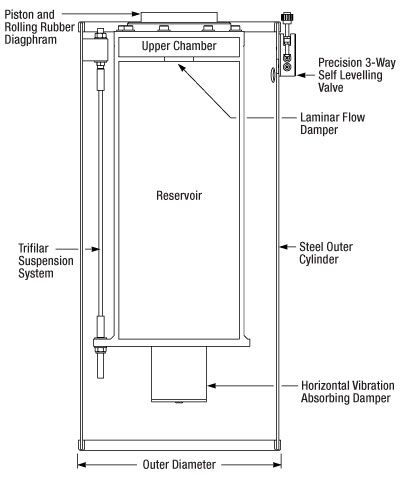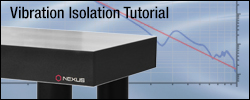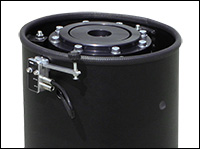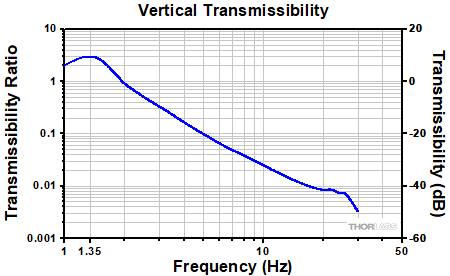Optical Table Supports: Active Vibration Isolation

- Excellent Vertical and Horizontal Isolation
- Extremely Low Resonant Frequency
- Self-Leveling for Constant Height
- Heights: 450 mm (17.7"), 600 mm (23.6"), and 700 mm (27.5")
PTS602
600 mm Tall
PTS603
700 mm Tall
PTS601
450 mm Tall
Application Idea
Active Isolation Legs Being Used to Support an Optical Table

Please Wait
| Key Common Specificationsa | |
|---|---|
| Vertical Resonant Frequency | 1.35 Hz |
| Horizontal Resonant Frequency | 1.0 Hz |
| Vertical Transmissibility at 10 Hz | -32.5 dB (97.5%) |
| Horizontal Transmissibility at 10 Hz | -30 dB (97%) |
| Maximum Load Capacity (Set of Four) | 2500 kg (5500 lbs) |
Features
- Active Vertical and Horizontal Vibration Isolating Supports
- Oil-Free Design
- High Load Capacity: 2,500 kg (5,500 lbs)
- Compatible with All Thorlabs' Nexus® Optical Tables
- Self-Leveling Valves Keep the Optical Table at a Constant Height with Fast Settling Times
- Extremely Low Resonant Frequency:
- Vertical: 1.35 Hz
- Horizontal: 1.0 Hz
- Maintain 910 mm (35.8") Optical Table Working Height
- 450 mm (17.7") Legs for 460 mm (18.1") Thick Optical Tables
- 600 mm (23.6") Legs for 310 mm (12.2") Thick Optical Tables
- 700 mm (27.5") Legs for 210 mm (8.3") Thick Optical Tables
Thorlabs' Active Vibration Isolation Optical Table Supports contain an isolation system that effectively isolates the optical table from vertical and horizontal vibrations throughout the critical 3 to 50 Hz frequency range. This is ideal since most common large-amplitude sources of vibrations found in laboratories vibrate within this range of frequencies (see the Vibrations tab of the Optical Tables Tutorial).
When the active optical table supports are paired with a Nexus® series optical table and setup in a quiet environment, even the most vibrationally sensitive photonics experiments like interferometry, holography, and nanopositioning can be performed. In addition, the active optical table supports can be used to dramatically reduce the vibrations transmitted to an optical table setup in a noisy environment like on the upper floor of a steel framed building (see the Selection Guide tab).
Vertical Isolation
The vertical vibrations are isolated from the optical table by a dual-chamber pneumatic isolation system that requires a constant source of compressed air, such as an air compressor (sold separately). If the source of compressed air is removed, the optical table will lower until it securely rests on the large-diameter cylindrical optical table supports, and the table will no longer be isolated from floor vibrations.
Horizontal Isolation
The horizontal vibrations are isolated from the optical table by mounting the vertical isolation system on a trifilar suspension system. This proprietary design eliminates the need to use oil-based damping systems that can leak or degrade over time.
Self-Leveling Valves
Each optical table support is also equipped with a 3-way valve. The valve regulates the pressure in the pneumatic isolation system to control the height of the optical table. If the table is displaced vertically, the 3-way valve will allow the pressure in the dual-chamber air reservoir to increase or decrease, as necessary, so that the table is returned to its original height. More information about the function and construction of the optical table supports can be found under the Design tab or in the Isolation Systems tab in the Optical Tables Tutorial.
Tabletop Height
To accompany our three optical table thicknesses, 210 mm (8.3"), 310 mm (12.2"), and 460 mm (18.1"), our optical table supports are available with heights of 450 mm (17.7"), 600 mm (23.6") and 700 mm (27.5") to produce a working height of 910 mm (35.8"). A set of four isolators is capable of supporting loads up to 2500 kg (5500 lbs) and full installation instructions are included. More than four isolators may be necessary for higher loads, long tables, or custom-designed joined systems. Please contact Tech Support to discuss your specific requirements.
| Active Vibration Isolator Specificationsa | |||
|---|---|---|---|
| Item # | PTS601 | PTS602 | PTS603 |
| Leg Height | 450 mm (17.7") |
600 mm (23.6") |
700 mm (27.5") |
| Vertical Resonant Frequency | 1.35 Hz | ||
| Horizontal Resonant Frequency | 1.0 Hz | ||
| Vertical Transmissibility at Resonance | 10 dB | ||
| Horizontal Transmissibility at Resonance | 12 dB | ||
| Vertical Transmissibility at 5 Hz | -20 dB (90% Isolation) | ||
| Vertical Transmissibility at 10 Hz | -32.5 dB (97.5% Isolation) | ||
| Horizontal Transmissibility at 5 Hz | -24 dB (94% Isolation) | ||
| Horizontal Transmissibility at 10 Hz | -30 dB (97% Isolation) | ||
| Maximum Load Capacity (set of four) | 2500 kg (5500 lbs) | ||
| Height Adjustment Range | -13 mm, +5 mm (-0.51", +0.2") | ||
| Self Leveling Repeatability | 0.5 mm (±0.02") | ||
| Air Pressure (Maximum) | 80 psi (551 kPa) | ||
| Finish | Black Paint | ||
| Vibration Sources and Their Approximate Contributions | ||
|---|---|---|
| Types | Frequency (Hz) | Typical Amplitude (inches) |
| Air Compressors | 4 – 20 | 10-2 |
| Handling Equipment | 5 – 40 | 10-3 |
| Pumps | 5 – 25 | 10-3 |
| Building Services | 7 – 40 | 10-4 |
| Foot Traffic | 0.5 – 6 | 10-5 |
| Elevators | Up to 40 | 10-3 to 10-5 |
| Building Motion | 46/Height in meters | 10-1 |
| Building Pressure Waves | 1 – 5 | 10-5 |
| Railroada | 5 - 20 | +/-0.15g dB |
| Highway Traffica | 5 - 100 | +/-0.001g dB |
Transmissibility
An optical table system is subjected to continuous vibrational impulses from the laboratory floor. These vibrations may be caused by large machinery within the building or even by wind or traffic-excited building resonances (swaying). Transmissibility is a measure of the isolators efficiency at damping out these vibrations and is defined as the ratio of the amplitude of the transmitted vibration to that of the forcing vibration.
Other common ways to represent this ratio are:
Percent of isolation = (1 - transmissibility ratio) x 100 or
Isolation in dB = 20 x log(transmissibility ratio).
At resonance, the system amplifies the input vibration so that the transmissibility ratio is greater than one. The transmissibility ratio is dependent on several factors; for instance the ratio will be dependent on the load placed on the isolators. Remember that the isolators only damp vibrations transmitted through the legs of the frame from the floor; air handling systems are often a significant source of vibration that is transmitted to the work surface through the air. As a result, in applications particularly sensitive to vibrations a comprehensive evaluation of the environment is recommended before choosing a vibration isolation platform. For more information on this topic please see our Vibration Isolation Tutorial.

| Feature | Design |
|---|---|
| Vertical Vibration Isolation | Dual-Chamber Damped Pneumatic Spring: Vertical damping is achieved by the use of a dual-chamber, damped pneumatic spring. The table is supported by the air pressure in these chambers. A piston, clamped to the bottom of the table, is sealed to the upper chamber with a rolling rubber diaphragm, allowing virtually friction-free motion between piston and chamber. Floor or tabletop motion forces air to flow from one chamber to the other through a laminar flow damper. This restriction of airflow damps oscillatory motion between the floor and table, dramatically reducing settling time. The volume ratio of the chambers has been optimized to minimize the resonant frequency of the optical table support while maximizing the damping performance for our complete range of tabletops. |
| Horizontal Vibration Isolation | Trifilar Suspension System: Damping of horizontal vibrations is accomplished by supporting the pneumatic vertical isolator on a trifilar suspension system. This innovative pendulum design uses gravity to provide the restoring force after horizontal disturbances. Horizontal oscillations at the system’s resonant frequency are damped by linking the base of the vertical isolator to the outer cylinder with an oil-free vibration-absorbing damper. |
| Self-Leveling System | 3-Way Air Valve: To allow for changes in load distribution, the active vibration isolation optical table supports have a self-leveling system based on a precision 3-Way valves that do not compromise vertical isolation when the system is at rest. Because these valves are actuated by tabletop movement, the system returns to its original level position within ±0.5 mm (0.02") after disturbances. Additionally, this system allows the table height to be adjusted over a range of 18 mm (0.7") and can be used to compensate for an uneven floor. These isolators require a constant supply of air. When the air supply is removed, the tabletop rests securely on top of the legs with the isolation system disabled. |
| Stable Support | Large-Diameter Cylindrical Design: The large-diameter, free-standing optical table supports provide maximum stability and safety, without the need for cumbersome tie bars that add additional resonances to the support system. The low vertical and horizontal transmissibility of these cylindrical isolators results in the least possible relative tabletop motion while the proprietary design uses no liquids that could leak or degrade over time. |
| 910 mm Working Height | Cylindrical Steel Supports: To accompany our thee tabletop thicknesses, 210 mm (8.3”), 310 mm (12.2”), and 460 mm (18.1"), our isolation systems are available at heights of 700 mm (27.5”), 600 mm (23.6”), and 450 mm (17.7") to produce a working height of 910 mm (35.8”). |
| Posted Comments: | |
David Espinoza
(posted 2023-06-26 10:25:20.053) Hi,
A table and four PTS602 legs arrived to the lab where I work. Can you assist me to know which air tank and regulator are the best option for them?
Thank you,
David Espinoza do'neill
(posted 2023-06-27 05:25:52.0) Response from Daniel at Thorlabs. Our PTA52X compressor is designed to work with our legs and has a built in regulator and filter. If you have a different air supply we would recommend using our PTA013 filter/regulator. Stephane Clemmen
(posted 2022-04-23 16:41:32.36) Dear Sir, Madam,
We'd like to use those legs (PTS601) with another Brand table (Meilles Griot) weighting 580kg.
Do you have experience of this being done with those legs? Do you see any compatibility problem?
Best regards,
Stephane Clemmen DJayasuriya
(posted 2022-04-26 09:37:41.0) Thank you for your inquiry. The four legs should be able to hold the weight with out an issue. We have got in touch with you directly to get a bit more information on the table. karen.guevarra
(posted 2018-01-04 02:29:30.213) Hi,
I would like to inquire also for PTS603- Optical Table Supports: Active Vibration Isolation, 1pc. only.
Thank you so much!
Regards,
Karen
Purchasing Assistant
NSB Engineering Design and Fabrication
#309 Manuel L. Quezon St., Lower Bicutan, Taguig City
Philippines tfrisch
(posted 2018-01-04 11:42:42.0) Hello, thank you for contacting Thorlabs. I have sent your request to our Sales team (Sales@Thorlabs.com). They will contact you about a formal quote or order. j.degallaix
(posted 2016-12-16 10:09:47.883) Dear ThorLabs officer,
We are having an issue on a Melles Griot self leveling isolator foot (ref 07 OTI 35). Melles Griot stopped producing those feet but the Thorlabs ones are amazing close in term of performance and size.
So first, could you sell only one piece from the set of the 4 feet ?
Second do you reckon your system is compatible with the previous Melles Griot one ?
Thanks in advance for your answer, best regards bhallewell
(posted 2016-12-22 05:45:59.0) Response from Ben at Thorlabs: Thank you for your question. I will contact you directly to discuss this. dconnell
(posted 2013-06-11 09:41:05.63) The price for a set of four isolators is about $3000 and the price for a bench with isolators like PFA51505 is $2600. Is there a significant difference in the type of isolators used in the bench just that cost is less? jlow
(posted 2013-06-11 11:16:00.0) Response from Jeremy at Thorlabs: The isolators used in the PFA series frame is a smaller version of the ones used in the PTS series legs. There are some slight differences with the specifications because of that. jlow
(posted 2012-11-07 11:26:00.0) Response from Jeremy at Thorlabs: The majority of the components used in the isolator are magnetic. Therefore, making this would be quite a challenge. I will get in contact with you to discuss about this. bdeng
(posted 2012-11-06 16:53:07.61) Please quote a set of 4 nonmagnetic active vibration isolators with self leveling, 600 mm tall.
Thank you.
Bihe Deng
Tri Alpha Energy, Inc.
949-830-2117 ext. 117 tcohen
(posted 2012-04-04 15:43:00.0) Response from Tim at Thorlabs: Thank you for your interest in our tables. We have contacted you directly with some transmissibility data and information on the performance you can expect from our table supports. bala
(posted 2012-04-02 06:14:45.0) We are building our lab on a separate slab in the basement of the building. The typical specs are VC-E curve or VC-C curve(RMS velocity Vs.1/3 Octave band centre frequency) for the lab. Is it possible to define a similar spec for your best design optical tabletops with ultra-series isolation features? How it will perform if such optical table is installed in our VC-E lab Vs.VC-C lab?
Thanks jjurado
(posted 2011-03-24 10:48:00.0) Response from Javier at Thorlabs to yangruitao: Thank you very much for contacting us. There are a couple of options for compensating for uneven surfaces when using the active isolator supports. It is recommended to maintain a gap of 12 mm between the outer tube of the isolators and the bottom of the optical table; however, this height can be varied by using the the leveler included with each isolator. We have detailed information about this procedure on page 10 of the manual for these isolators:
http://www.thorlabs.com/Thorcat/17700/17717-D02.pdf
Alternatively, you can place sorbothane sheets between the isolators and the optical table to compensate for the uneven floor. Please visit the link below for our SB12A and SB12B 12" x 12" sorbothane sheets:
http://www.thorlabs.com/NewGroupPage9.cfm?ObjectGroup_ID=1867
The performance of the active system is not compromised when following either option.
I will contact you directly for further assistance. yangruitao5
(posted 2011-03-24 05:05:12.0) The floor we want to put this optical table is not even. The slope is about 4mm in 2meters. What can I do to compensate this uneven? Just adjust the valves or underlay the legs? If the table is leveled by adjusting the valves, will the isolation characteristic be the same with normal operating condition? Thanks klee
(posted 2009-10-26 09:19:45.0) A response from Ken at Thorlabs to lchienjung: The weight is for 4 legs. Please keep in mind thatt those are the shipping weights. The net weights are ~120kgs for the PTS603 and ~550kgs for the PTR52505. lchienjung
(posted 2009-10-26 02:31:28.0) The PTS603 is 132kg. =>one leg or 4 legs? klee
(posted 2009-10-23 18:29:06.0) A response from Ken at Thorlabs to lchienjung : The shipping weight for the PTS603 is 132 kg and the shipping weight for the PTR52505 is 597 kg. lchienjung
(posted 2009-10-23 07:59:42.0) One question
How many PTR52505+PTS603 weight is?
Part Number PTS603 is Active Vibration Isolation
Part number PTR52505 is UltraPlus Series of Optical Tables
THANKS! klee
(posted 2009-10-08 10:19:51.0) A response from Ken at Thorlabs to jh: Each set has 4 legs. jh
(posted 2009-10-07 21:12:30.0) How many vibration isolators are there in a "set". The price is specifed for a set but does not tell you how many.
Jeroen Heymans
+61 293724806
Anglo australian Observatory klee
(posted 2009-09-08 08:52:24.0) A response from Ken at Thorlabs to jason.frye: What we mean by "active" is "actively self-leveling". I apologize for the confusion. We are looking into changing it. jason.frye
(posted 2009-09-02 20:19:30.0) Why are you calling these isolators "active" when they are not? These are merely pneumatic isolators with leveling valves. Marketing these as active is simply wrong. |
| Optical Table Supports Comparison | ||||
|---|---|---|---|---|
| Support Legs | Active Vibration Isolation Supports | Standard Passive Vibration Isolation Supports |
Heavy-Duty Passive Vibration Isolation Supports |
Rigid, Non-Isolating Supports |
| Vertical Resonant Frequencya | 1.35 Hz | 4.42 Hz | 4.42 Hz | N/A |
| Vertical Transmissibility at Resonancea | 10 dB | 22 dB | 22 dB | N/A |
| Vertical Transmissibility at 10 Hza | 97.5% | 74% | 74% | N/A |
| Isolation Type | Active | Passive | Passive | Noneb |
| Load Capacity (Set of 4) | 2500 kg (5500 lbs) | 275 - 1100 kg (600 - 2425 lbs) | 550 - 2400 kg (1200 - 5280 lbs) | 2500 kg (5500 lbs) |
 Products Home
Products Home











 Click to Enlarge
Click to Enlarge
 Supports with Active Self-Leveling Isolators
Supports with Active Self-Leveling Isolators